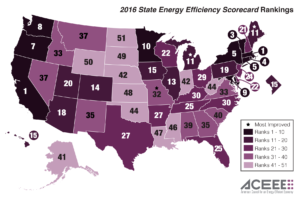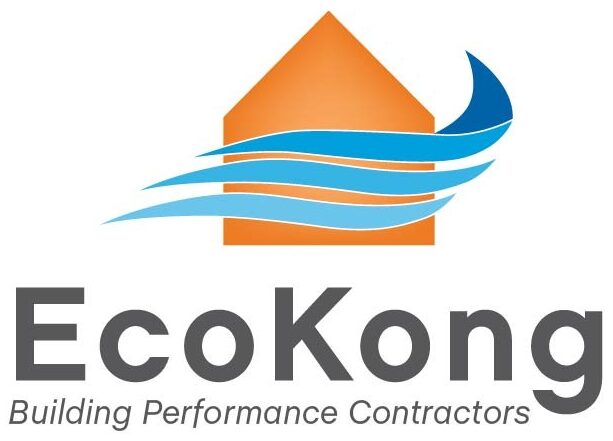- By Hugh Wolf
- In Uncategorized
2016 Energy Efficiency
 Another year of significant gains for energy efficiency –efficiency is not only the most cost effective way to avoid dirty power plants, waste less and save more, but also create jobs and grow the economy. The underlying uncertainty in policy under the incoming administration and recently tapped Rick Perry (yet to be confirmed) for the DOE-Department of Energy leads one to wonder whether the trend will continue beyond 2016. Considering the large benefits which investments in Energy Efficiency brings to the economy, pubic health, and jobs the question is this: why wouldn’t this trend continue? While bad federal policies can and will delay progress, increases cost of meeting carbon footprint reduction goals, and make the US economy less competitive, we still can rely on state policy and utility investment to keep us moving forward.
Another year of significant gains for energy efficiency –efficiency is not only the most cost effective way to avoid dirty power plants, waste less and save more, but also create jobs and grow the economy. The underlying uncertainty in policy under the incoming administration and recently tapped Rick Perry (yet to be confirmed) for the DOE-Department of Energy leads one to wonder whether the trend will continue beyond 2016. Considering the large benefits which investments in Energy Efficiency brings to the economy, pubic health, and jobs the question is this: why wouldn’t this trend continue? While bad federal policies can and will delay progress, increases cost of meeting carbon footprint reduction goals, and make the US economy less competitive, we still can rely on state policy and utility investment to keep us moving forward.
Energy Efficiency Gives the Economy a Lift- 2016 Annual US energy consumption is about the same now as in 2000, despite growth in GDP of 30% over this 16-year period, due to energy efficiency. This trend can be seen going back as far the 1970’s when energy efficiency efforts began. Energy Efficiency accounts for nearly 1.9 million US jobs-10x times more than oil and gas drilling, 30x times than coal mining. The industry is projected to grow by supplying 245,000 high skilled jobs to the US job market.
Most People Appreciate Energy Efficiency- Most Americans overwhelmingly support wasting less and saving more in our residences and businesses, and has bi-partisan support. In fact, a 2016 post election poll conducted by Public Opinion Strategies for the Conservative network found 90% of Trump supporters ranked Energy Efficiency as important.
2016 Successes in Energy Efficiency- Clean energy and energy efficiency wasted less and saved more in energy bills while lowering multiple states carbon footprint. From those states who failed to invest in these resources are wasting more and saving less. Costs have doubled for the 5 lowest states, compared to the 5 highest states that invested in these resources and pursued strategically smarter energy use.
Highlights from 2016:
- Utilities: Exelon, with a broad coalition including NRDC, was instrumental in passing Illinois’ most significant piece of climate and clean energy policy in the state’s history. When enacted, Illinois will have one of the top energy efficiency programs in the entire nation, building on the success of laws passed in 2007 that helped build a local clean energy workforce of more than 85,000 jobs state-wide, two billion in consumer savings, and the lowest electric rates in the entire Midwest.
- Low income: The California Public Utilities Commission adopted major improvements to its longstanding low income energy efficiency program, expanding it to rent-assisted multifamily buildings to the tune of $80 million, and easing the energy burden on low-income households, in a decision that could become a national model.
- Cities: Through efforts of the City Energy Project, a joint initiative of NRDC and the Institute for Market Transformation, the City of Orlando recently passed an ordinance called the Building Energy and Water Efficiency Strategy, which is projected to save an estimated $208 million in energy costs, drive the creation of more than 500 local high-wage jobs, conserve 900 million gallons of fresh water, and avoid an estimated 1.1 million metric tons of carbon pollution over the next 15 years.
- States: California approved the nation’s first computer energy standards, which will reduce energy used by computers by one third to one half. In California alone, the new standards are projected to save more than 2.3 billion kilowatt-hours of electricity a year — equivalent to annual electricity use by all the homes in San Francisco. But if the standards become largely de facto national standards as expected, U.S. consumers will save up to $3 billion annually on their energy bills, and electricity use would be cut by the equivalent of seven coal-fired power plants.
- Regions: The NW Power and Conservation Council released a new regional plan that will produce the equivalent of more than a dozen giant coal-fired power plants’ worth of inexpensive energy savings over the next two decades. Proving that cheap savings keep growing back, about 40% of the savings come from technologies that were largely unknown as recently as five years ago.
- Department of Energy: DOE adopted several efficiency standards in 2016, including air conditioners and heat pumps, dehumidifiers, pool pumps, manufactured housing, beverage coolers, ceiling fans and air compressors. The air conditioner standards alone are projected to cut electricity use by 340 billion kilowatt-hours over 30 years of shipments, equivalent to the power used to cool U.S. homes for more than a year and a half and save consumers $24 billion in operating costs.
Global Benefits-Savings around the globe in 2015 reached a new high, equaling 13% of total consumption despite lower energy cost and higher global economic growth. China leads the way and is placing their future bets on a clean energy and energy efficiency standards.
2017 and Beyond-At the state and utility level the momentum is clear. Energy Efficiency proven benefits will continue to trend at these particular levels and even more with better by unleashing federal policies in order to stop any drag that they may cause. Two thirds of the energy efficiency economic potential remains untapped in areas where supportive policy is absent or inadequate. Will the USA miss out? The future is uncertain but you can help by calling Eco Kong Inc. Now at 480-788-7718 or email info@ecokong.org or visit our website at https://ecokong.org
